Title: Spatial Ecology of Water
Name/s of the Author: Meghal Arya
Name of the publisher: AADI Center, Ahmedabad, India
ISBN 9788190852845
MRP: 2500/- discounts available to students, academics and institutions
Number of Pages: 167 pages with drawings and photos associated with text
Binding: Hard and soft both
To order your copy, write to: [email protected] or [email protected]
INTRODUCTION FROM THE BOOK
The architecture for water transcends time and space in its proliferation across various geographies and cultures. From early settlements along rivers like Nile or Indus, to the wells in the Thar, these structures contributed to the anthropogenic relationship of water. In that sense, they have a deep connect to the people and the physical environment in which they are located.
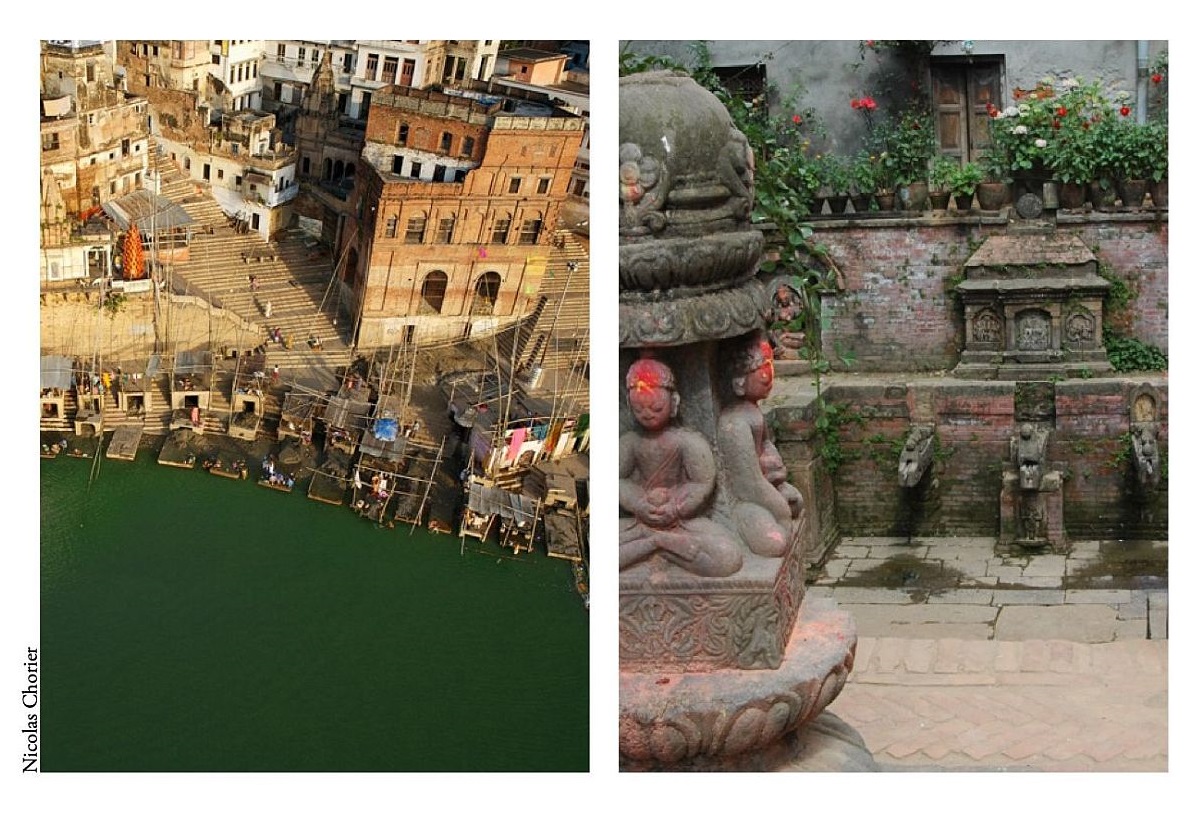
Right : A kund in Nepal is articulated with dieties indicating an associated religious function. Water from the mountains is collected and released through the spouts.
On the banks of the Ganga, the day starts with a salutation to the river; its waters are scooped up and tipped back as an offering to the gods and goddesses. The half-submerged individual with their hands cupping the water and acknowledging both, the river and the sun makes for one of the most ubiquitous images associated with all rituals connected to water on the Indian subcontinent.
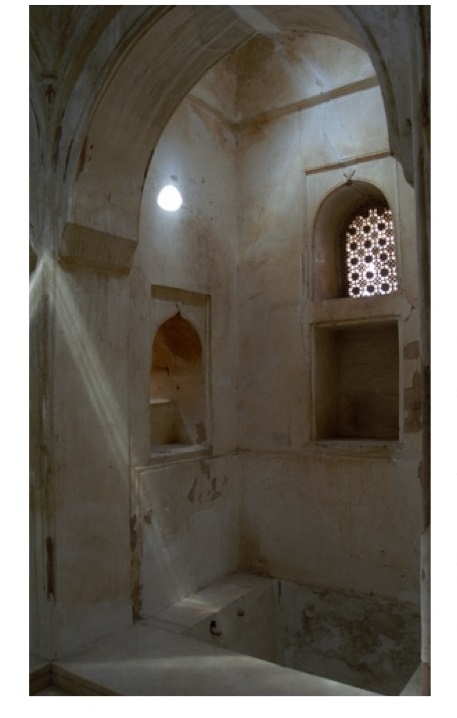
That amalgamation of the human body with the elements of Nature – water, sun, sky and air in a posture of communion and oneness is an embodiment of a way of life. It conveys the powerful life-giving attribute of water, while simultaneously layering it with the qualities of purification and sanctification. Though the image is transient, the emotion and the relationship have an endurance constituted by shared memories and continued practices. The ephemeral and yet perpetual presence of that image finds crystallization in the physical form given to that relativity between water, sky, earth and the human body. This gesture is the archetype of the myriad forms of reverence for water that can be found across the Indian subcontinent, be it the kund or the talaab, the bavdi or the kuan.
The life-giving property of water has entailed that every living organism has created mechanisms for its sourcing and absorption. Extraordinary ways of procuring water exist in nature, in tandem with the climate, terrain and with necessity.
Human beings, as they became a part of the journey of civilisation, also created unique and diverse methods as well as systems of making water available for sustenance. As Anzuni (2002) has observed ‘Of the four elements of the ancient Mediterranean cosmology, water is probably the one to whose control man has dedicated the most time, the one that more than the others has left its mark on human creation’ (35).
Every society and culture has had stories, fables and legends around water, its qualities and the invocation of its power. The powers have been personified in the hundreds of gods and goddesses like Poseidon, Indra or Neptune, with distinctive characteristics. Apart from its life giving characteristics, the earliest experiences of water included the harshness of flood and droughts, of excess and scarcity. Inevitably, the legends and myths included destruction due to the vagaries and appeals to the gods of water became part of the culture. Aztec mythology separated the god of rain, thunder and earthquakes from the goddess of rivers, seas and streams, while Indra in Hindu mythology is the god of lightning, thunder, storms, rains and river flows. It is claimed that Indra is the most referred to deity in the Rigveda. He is praised as the highest god in 250 hymns of the Rigveda and co-praised as the supreme in another 50 hymns, thus making him one of the most celebrated Vedicdeities (Griswold, 1971).
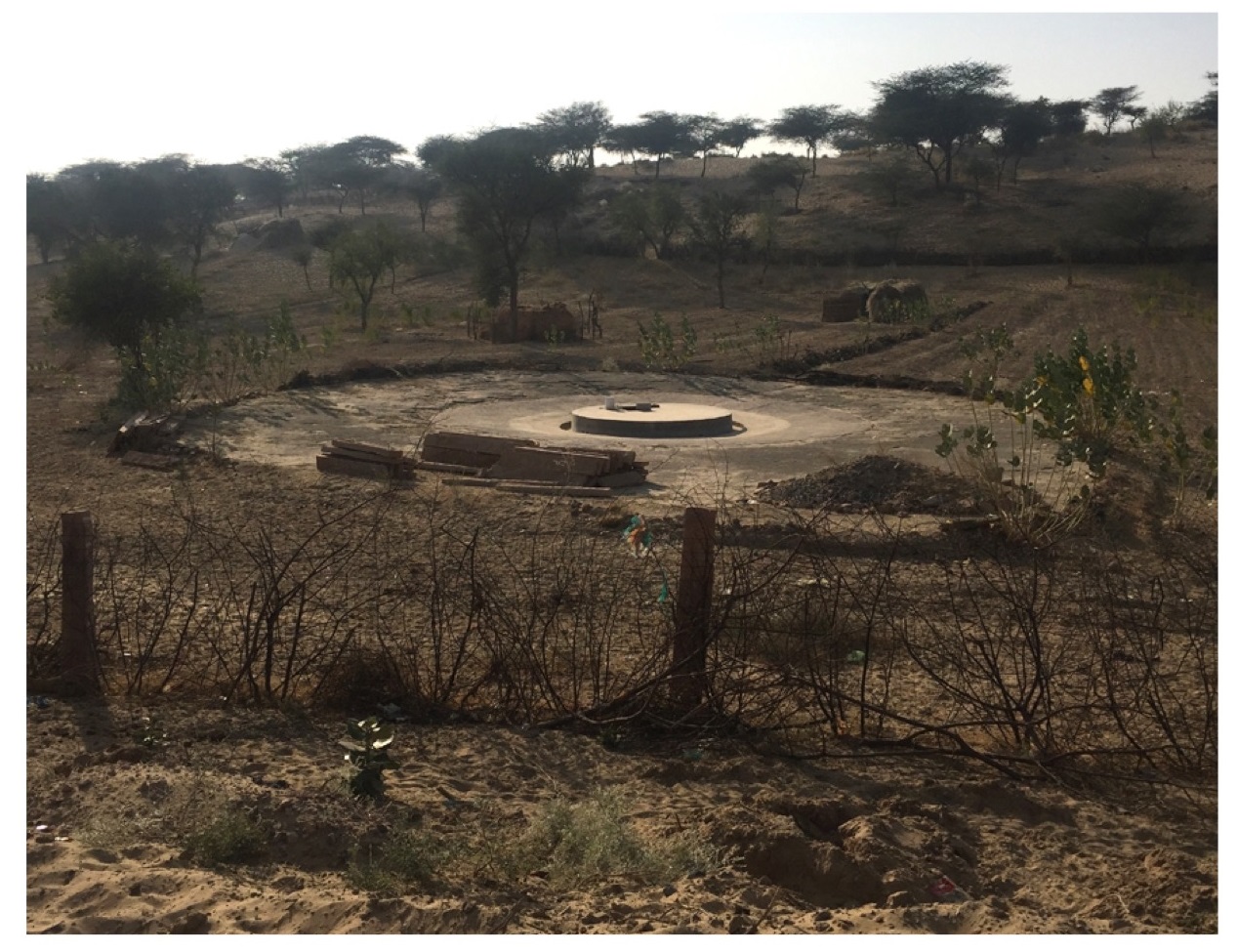
Of the five elements of Indian cosmology, namely air, water, earth, sun and ether, water was unpredictable with the most regularity. The experiences combined with the necessity of water eventually lead to sizeable efforts expended towards bringing water into some semblance of predictability. From there starts the story of managing water in human history.
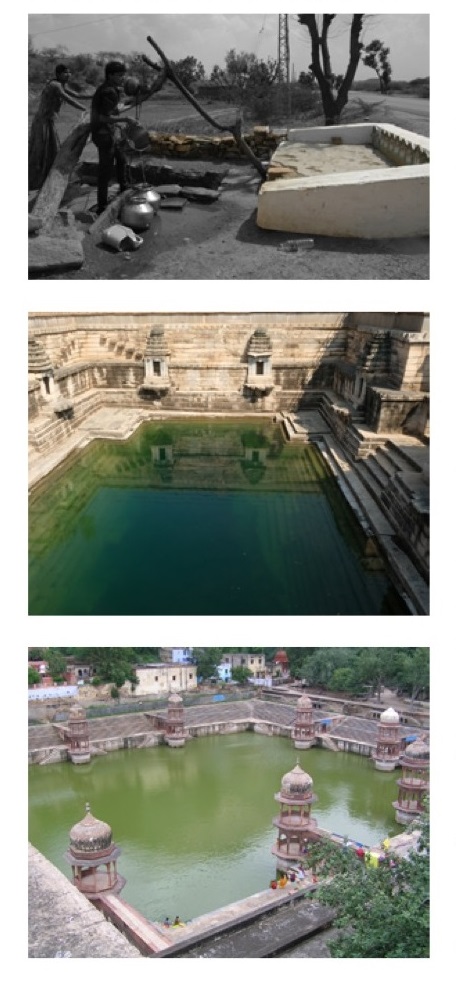
Bottom: The water tank at Alwar with its elaborate ghats and pavillions.
The creation of places for water was fundamental to a settlement. The most common expression was the emergence of early civilizations situated along the banks of rivers like the Nile, Tigris, Euphrates, Indus or Saraswati, the rivers being the continuous and natural source of fresh water for varied uses: pastoral, domestic, agricultural or industrial. The challenge was to manage and regulate large flows, subject to frequent and voluminous variations due to precipitation events and snowmelts. The flooding cycle determined the spatial structure of the proximate landscape.
Along the Nile, the settlements were deep-set with processional pathways to the river creating a large flood plain used for farming. The varying width of the river was absorbed by agriculture as networks of canals were created to manage the floodwater. The built-form occupied mounds of land left dry during flooding. The most significant monuments, the pyramids, built to last, were placed the farthest, symbolically situated between the life-giving river and the wasteland of the desert. The relationship with water was at once close and distant, based on fear as well as awe of the behaviour of the river. The irregular flooding pattern of the Tigris and Euphrates was dealt by harnessing ‘the waters with irrigation canals, dykes and reservoirs’ (Reader’s Digest, 1989:52).
In the Indian subcontinent, massive fortifications marked the Harappan cities which used diversion technology to manage the flooding of the Indus and Saraswati. ‘The town’s peripheral wall is massive, from 12 to 21 m thick, and was clearly intended to offer a measure of protection against floods, whose repeated onslaughts left tell-tale marks of ravage on the town…’ (Danino, 2010:161). Each civilisation, each generation and each geography articulated its relation to water through the definition of its architecture embedding within it the experience and observation of generations. The intrinsic relationship went far beyond the utilitarian as is evident inthe elaboration and articulation of the places of collection, storage and distribution of water. It included the recreational, the religious, the aesthetic, the spiritual and the ritualistic aspects. The architecture was instrumental in connecting people to the water as a tactile experience. Water could be seen and touched, accessed and entered into. The joy of celebrating a scarce resource was evidenced in the built form. It also marked the evolving nature of human achievements in construction, technology and scientific thinking.
The spatial relation between water and the built form changes dramatically in the arid regions that are without significant river systems. There is no visible regular source of water which can be depended upon. With highly irregular and sparse rain events, the challenges, there, are of less rather than more. High temperature variations, dry weather and scanty rainfall create scarcity conditions that demand skill and human ingenuity for survival. It was in such regions that keen and continuous observation helped evolve a deep understanding of the patterns of nature that combined with strategic resource management contributed in crafting resilient settlements that thrived in the adverse conditions.
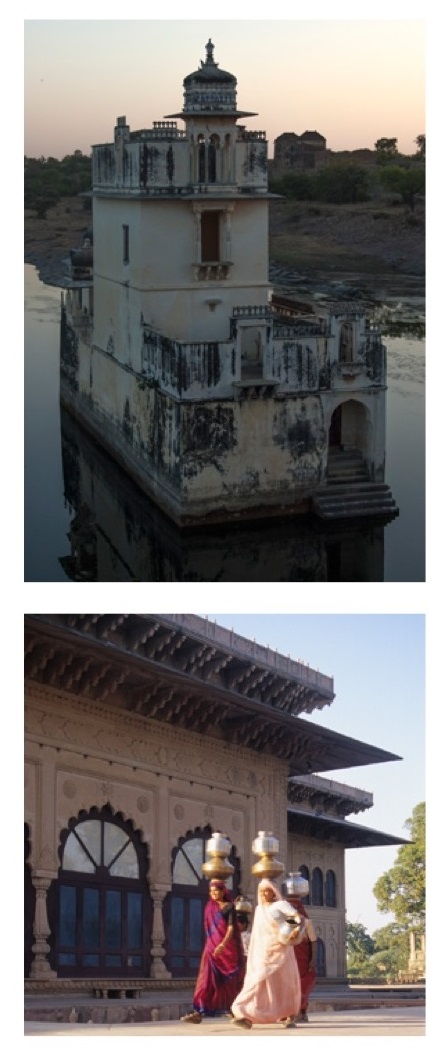
Bottom: Women collecting water in the evening from the tank in Deeg
The aridity and drought-like conditions led to heightened historical human efforts in constructing a close, immediate and direct relation to water; it was a paradigm shift from distance to proximity. There was a significant transference in the human relation with water, from hapless observer, to managing and controlling the flow. From thick walls, high platforms and canals, the narrative of architectural response shifts to ghats, wells, kunds and bavris. The spatial entities embrace the relationship to the arid land, forming cultural landscapes of pause, benevolence, frugality and celebration. They shape an ecosystem linking nature with society.
These hydraulic structures inspired a dissertation on the ‘Embedded Knowledge in Architecture – a study of the water structures of arid India’ for a doctoral degree from which this book is derived. It was based on the premise that architecture, as a part of the material culture of a society, had, inscribed in it the collective learning and experience of society, in particular with reference to its specific methods and techniques of harvesting and storing water. The research began with an intense concern about the wasteful manner of water consumption in contemporary society. The human indifference towards water on earth, an element, the tiniest hint of which on any of the other planets would evoke high excitement, is paradoxical. Though the significance of water for life is recognised, the sense of responsibility towards its consumption is limited with misconsumption and wastage being one of the main problems in urban environments. The renewability and continuous recharging of water has led to a neglect of this wondrous element creating a crisis moment. It compels a serious research into how societies, historically and traditionally, created a sensitive, considered and weighted response to water.
An overview of the architecture for water in the desert shows a tremendous range of type and tectonics like wells, tanks, dams, reservoirs, fountains, channels, canals, baths and aqueducts. Entire precincts were organized on the premise of water like the Alhambra, the palaces of Deeg or the Fort of Ahhichatragarh. Elaborate articulation, diversity of scale and type contribute to the experiences of these precincts.
The Iranian system of qanats connecting thousands of wells in the hills to the towns and cities is an extremely sophisticated hydraulic system. Together with Abanbars, Yakhchals, dams and water mills, this architecture for water dating back more than 2500 years continues to be operational. ‘Persia is currently benefiting from 31000 active qanats producing some 9 billion cubic meters of the groundwater and forming some 15% of the aquifer discharge which is annually mined across the country. This huge amount of water is amazingly conveyed just by means of gravity. Since no electric or fossil energy is employed, this system is pollution free and bears no environmental contaminants’ (Sanizadeh, 2008:27). The arid regions of India demonstrate a similar systematic and resourceful predilection towards rainwater harvesting. Ingenuous techniques to capture and store rainwater, replenish and source groundwater evolved due to perpetual shortage. With the engineering and planning feats, cultural, geographical and temporal variations are manifest in the myriad expressions of architecture for water as will be shown in the following pages.
The concepts discussed in this book are derived from the study of the architecture for water of Jodhpur in Rajasthan. It offered a rich and layered understanding of the deeper structural and spatial constructs woven around the water structures. The relationship of spatial planning to geological considerations can be seen in the settlement that took shape 600 years ago. This book discusses their close relation with communities, their role as spaces of everyday living and their presence as urban public spaces. As the water collection for household purposes was irrevocably entwined around the lives of women, they were gendered spaces of a city. They played a critical role in folktales, songs, rituals and social behaviour including the specific references to water and its significance. The songs for rain are a part of every childhood experience in the Indian desert.

Bottom: Dada Harir ni Vav in Ahmedabad is seen as a stand alone artifact.
Today, most of the traditional infrastructure for water lies unutilized, neglected and derelict as water reaches homes through pipes fed by canals originating in dams located hundreds of kilometres away. The Bhakhra Nangal Dam providing water to Jaisalmer is 880 km away and the Sardar Sarovar is about 500 km away from Bhuj while Gadisar, Amar Sagar and Hamirsar, within the city precincts, lie unused, recognised only as places of touristic interest. The 2017 National Register of Large Dams accounted for 5254 large completed dams in the country while 447 were purported to be under construction and the number continues to grow.
The historic water structures have become dumping yards and landfills, alienated from the socio-cultural and environmental contexts, often courtsey the borewells and hand pumps supplied through misunderstood charitable considerations. They are defaced and vandalized, sometimes even by the state, which installs new pumping systems without any regard for the architecture, the history or the value of the sites as social spaces. Few, like the Chand Baori in Abhaneri or Rani ki Vav in Patan, receive some attention as architectural monuments but not as living, breathing spaces of human inhabitation. These are arrested in time, detached from human engagement and seen as being evocative by their ruinous character or embellishments rather than as components of a system managing an all important resource. Their purpose and context are rarely understood or acknowledged. Built to last for centuries, these structures are lost to modern human lives due to apathy.
The mechanical and centralized structure of providing water fractures the relation between the individual and the community. It contributes to a sense of entitlement, without the attached responsibility. Citizens are provided resources like water with little regard for the location of the source. Piped and cloaked under layers of earth, the movement of water, its collection, storage and distribution is erased from our urban sensibilities and memories. The resulting detachment presumes the responsibility of conservation and supply to be of the state mechanism alone. The tactile connection, experienced through the architecture, is eliminated, or reduced to that of a view. Knowledge and information of this infrastructure remains limited and sparse. To counter the homogenizing and monocultural trends of the contemporary world, it is important to put the knowledge about these water structures and their contribution to the making of societies in the public realm, to make this accessible in order to initiate a productive dialogue. This book contributes towards such a dialogue, provoked from a concern about how we ‘view and perceive’ our resources.
With new emerging conditions of human development, we are now beginning to seek answers in history, looking at traditional structures to redeem the ancestral relations. The structure of decentralization and self-reliant communities through innovative means of social collaboration and interaction is being examined for its potential to provide alternatives to the centrally organized and distributed systems. Future directions can be anticipated to seek organizational structures that better valourize individuals and communities together with their human, creative and entrepreneurial potential.
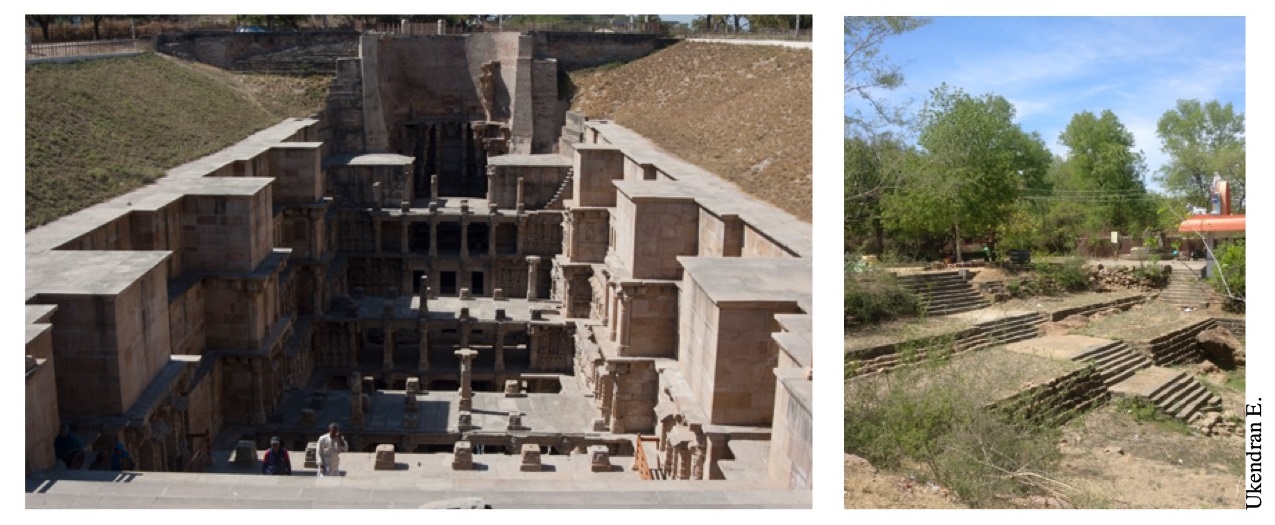
Top: Neeruthi Tirtham in Tiruvanamalai lies on the circumabulatory path around the sacred hill, Arunachala, visited annually by lakhs of pilgrims and yet is neglected.
Indian architecture has received scholarly attention primarily for iconography and historiography with a focus on the classical and the religious (Kramrisch, 1946, Dhaky, 1996, 1998, Tadgell, 1990, Brown, 1983) keeping in line with the idea of centrality. Scholars and philosophers of Indian aesthetics like Coomarswamy (1909) or Kapilavatsyayan (2010) connect the artifact to its spiritual genesis. Structural and morphological studies like Hardy’s work on the tectonic analysis of the Indian temple have been few.The other area of interest has been in the vernacular. There, much of the research has been done in the nature of documentation and analysis of the houseform (Jain 1992, 2000, Thakkar, 2008, Desai, 2018).
Architects, anthropologists, archaeologists and historians seek either the monumental and or the vernacular, but the public architecture of daily living is overlooked. The large number of wells, tanks and lakes that dot the landscape of civilisation are relegated to a mundane presence though they are rooted inextricably to the place and entwined within the geography and the social practices. They were once designed to be selfsustaining, with a strong community fostering of relations, inclusive of a place for the individual. Hence, the water structures are the ‘ordinary’, ‘secular’, and ‘public’ architecture of India, a study of which can contribute immensely towards an understanding of the design, the continuum and the development of Indian traditional architecture in the context of society. This book presents the research outcomes, focusing on the relation of people to their environments, that is found as embedded knowledge in the architecture of the place. Significantly, it is able to demonstrate that these structures are not isolated entities in the landscape but are interlinked and connected.
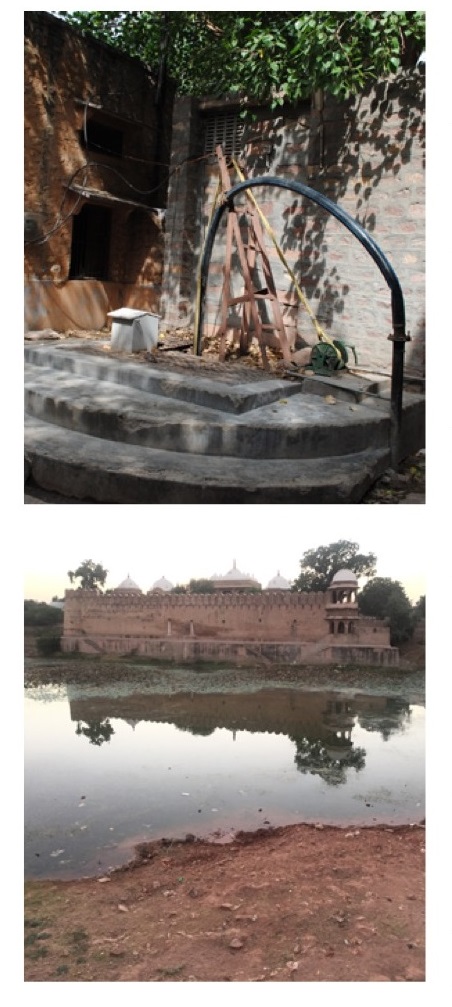
Bottom: A lake in Nagaur is now being used as a garbage dumping site. Neglect has led to its being overgrown with vegetation causing eutrophication and loss of water quality
Anupam Mishra’s (2001) contention that Rajasthan is not a water-deficit region due to the diligence, ingenuity and intelligence of the people along with the wisdom accrued through time demands serious attention. Through the Radiant Raindrops of Water, Mishra conveys the personal and integral relationship of the people of Rajasthan with the water bodies laying a deep emphasis on the micro-regional nuances. The belief in a decentralized, localized system of procuring water, with community ownership as a better way of self-sustenance in water is reiterated through examples where the state systems have failed in their obligations and the local systems continue to endure. His is a passionate text, poetic in its rendering of the information and of oral knowledge. Other environmentalists and activists like Rajender Singh, Farhad Contractor, Jal Bhagirathi Foundation have also researched the traditional water structures to support advocacy of a localized, decentralized system of harvesting and accessing water. They seek to mitigate present water scarcity issues and encourage local people to revitalize the existing structures and/or make new structures based on the traditional knowledge of the area. Stemming from anti large-dam sentiments, this view ultimately connects water structures to the politics and economics of the society within which they occur.
Agarwal and Narain (1997) published Dying Wisdom, an exhaustive compilation of traditional rainwater harvesting and irrigation systems across India, an almost biblical document on the subject. The challenge of organizing the vast data was accomplished by classifying the water bodies according to geographical subdivisions. Implicit in this classification was the deep connection of the water body and its analogous system with its immediate environment. Dying Wisdom documents the changes in the irrigation systems from personal small canals and wells to state undertaken large-scale canals, making a strong case for investing in these systems to mitigate water scarcity. It has been one of the first such documents that appreciates and brings into the written framework, knowledge and wisdom conveyed through observation and continuous engagement with the environment, most which is lost in today’s society.
The preoccupation with the monumental sidelined the public architecture of daily living, though vernacular studies as mentioned earlier, have documented and analysed the houseform. Exceptions include studies of water structures as fascinating artifacts of human inventiveness such as Mankodi’s research in the 1980s; a detailed study of the Rani ki Vav including an analysis of the structure, the construction and an interpretation of the iconography. Most subsequent researchers refer to Mankodi’s analysis, particularly the description of the making of the well and the stepwelll. Dr. Jutta Jain-Neubauer’s (1981) survey of the stepwells of Gujarat, the first of its kind, locates each in its time, political and geographical context.
Brief descriptions of the basic elements like entrances, steps, pavilions, etc. to identify the building type sets its research methodology within the framework of the artifact as an independent entity. The typology is based on her reading of ancient texts like the Visvakarma Vastushastra, Aparajitaprccha, Manasara, Mayamata etc. Hers is a valuable historiography that coalesces observations of scholars like Dhaky, Cousens and Burgess with a study of the iconography to create a chronology, relying on inscriptions found at the sites of the wells. She continues to look at the stepwells as artifacts to be appreciated for their built expression rather than in any relation to the society, culture and environmental context of their making.
Another doctoral research on water and architecture published in 2002 is Julia Hegweld’s The Water Architecture of South Asia, her primary argument being that the water structures have been studied for their technological aspects of hydrology, but not in terms of ‘common features existing in architectural structures’ (9). She classifies them as five groups: ghats, deep-stepped basins, tanks, wells and ornamental pools, each described for its architectural form, the variations and the construction method. It thus, brings architectural focus, hitherto inadequate, into this type and realm. Given that she frames the study within the formal organisation of architecture, she is limited in her presentation of geographical or social relationships. Parallel to Hegeweld, Morna Livingston (2002) had embarked on her own personal photo journey through Gujarat, presented in Steps to Water creating an evocative document calling upon sociocultural, spatial and environmental information to provide the photographs with a context. The focus is on the rituals and the social practices. It serves the purpose of preliminary documentation of a fragile and vulnerable form of architecture and presents it to a wider audience. However, a methodology that researches the water structures in-depth and their central location within a settlement, in order to understand various interconnections is missing from the discourse.
This book brings into the public realm, a particular study conducted on the water systems of Jodhpur. It enables the articulation of a vast repertoire of a significant architectural legacy, which has not been given a voice thus far. By studying and extracting the knowledge in the architecture for water, this research hopes to strengthen the need to assess the potential of the traditional systems to contribute actively within settlements, in particular within today’s urban context.
The water structures of Jodhpur are studied as embodiments of cumulative knowledge systems of a society. They are presented through an interpretative lens associating everyday practices, technological aspects and environmental relations closely with the architecture. It combines hermeneutic research with historical research to fulfill its aim of furthering knowledge about Indian traditional architecture, in particular the water structures of the desert. The geographical limitation permits a deeper research within the area of interest while presenting possibilities to seek relations that remain hidden or neglected. This offers the possibility of understanding the water structures as parts of an intricate and well-thought out system or a network.
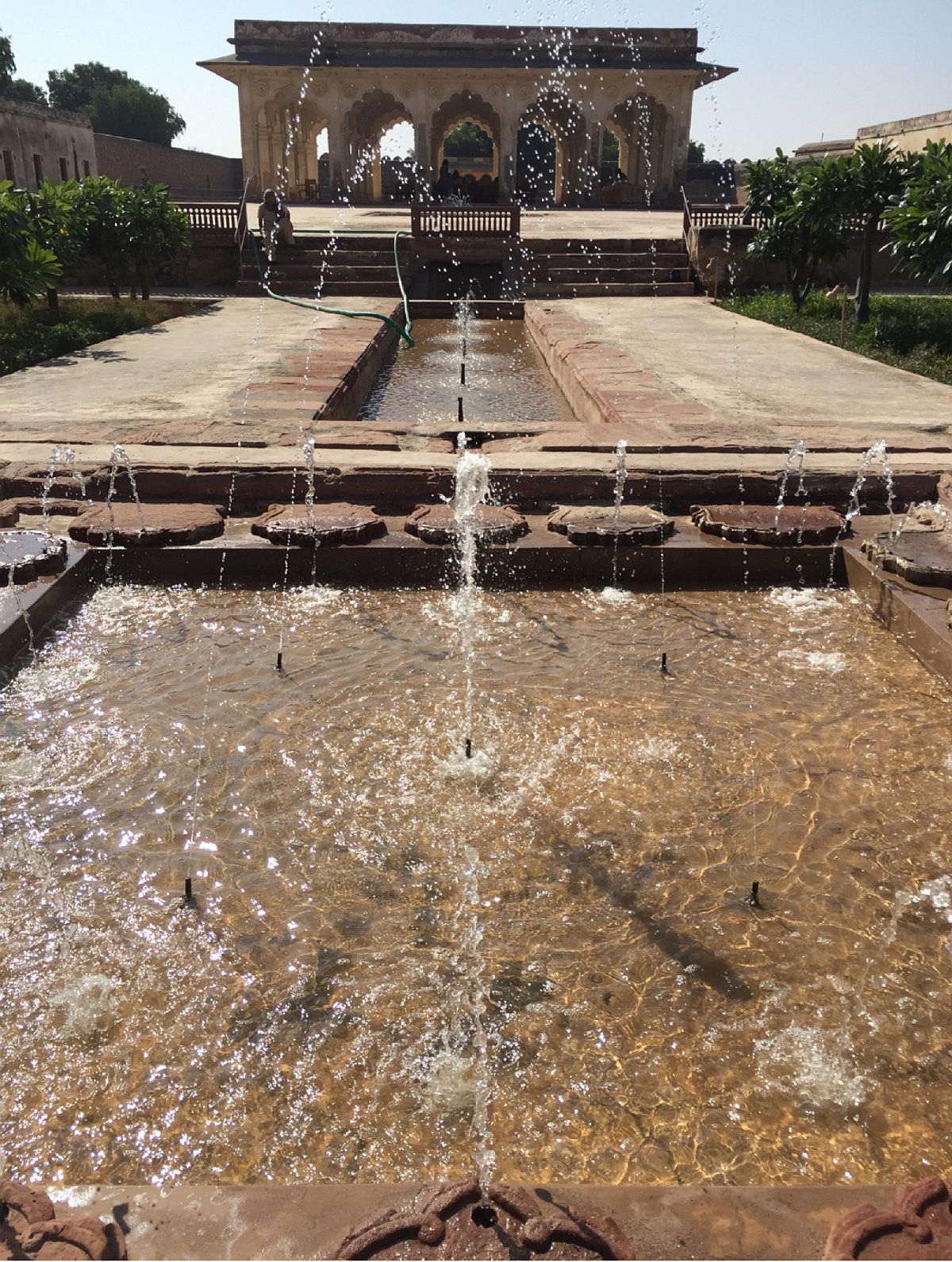
The settlement can be comprehended relative to its territory. This position consolidates the understanding that the individual instances of architecture for water in a settlement are strung together through strong intangible and tangible relationships. This book eventually argues that the fundamental relationship of people with their resources, water in this case, has undergone a paradigm shift and ‘lost both its power to communicate by touch, its deep-seated purity and its mystical power’ (Illich, 1985:25) requiring a rethinking on the manner of appropriating the traditional systems within modern policies and governance structures. This knowledge foresees the potential to contribute to our resilience on this planet, in a harmonious and sensitive manner.









